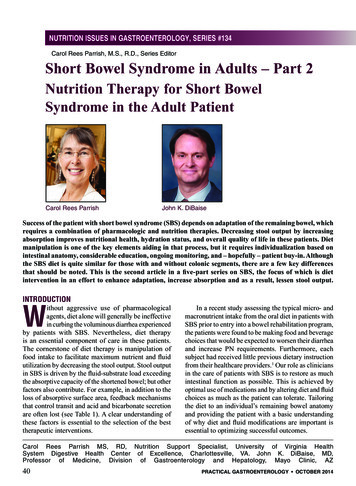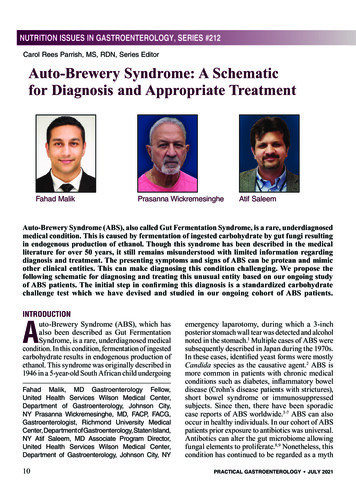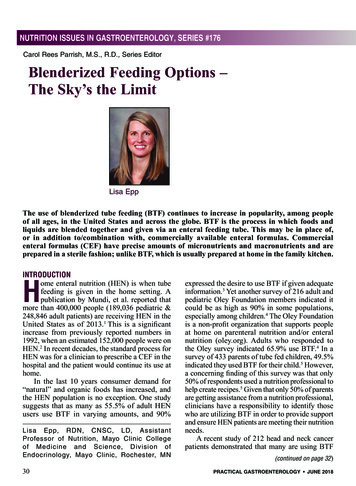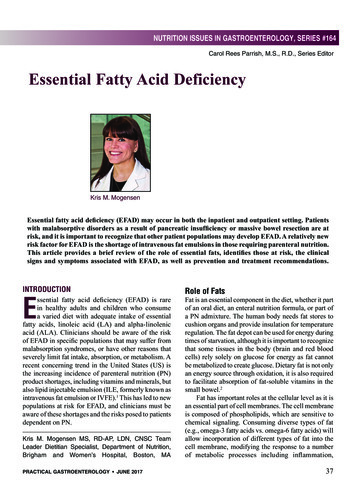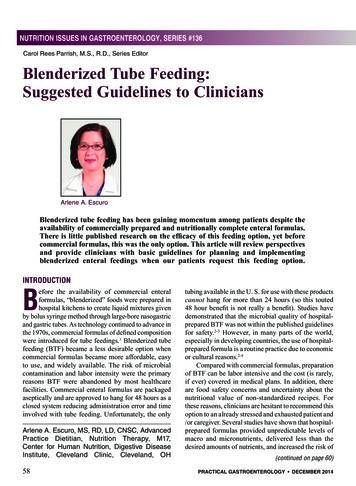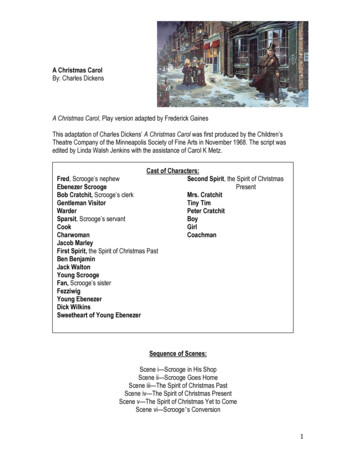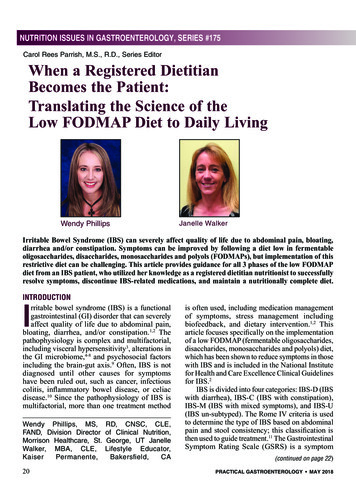
Transcription
NUTRITION ISSUES IN GASTROENTEROLOGY, SERIES #175Carol Rees Parrish, M.S., R.D., Series EditorWhen a Registered DietitianBecomes the Patient:Translating the Science of theLow FODMAP Diet to Daily LivingWendy PhillipsJanelle WalkerIrritable Bowel Syndrome (IBS) can severely affect quality of life due to abdominal pain, bloating,diarrhea and/or constipation. Symptoms can be improved by following a diet low in fermentableoligosaccharides, disaccharides, monosaccharides and polyols (FODMAPs), but implementation of thisrestrictive diet can be challenging. This article provides guidance for all 3 phases of the low FODMAPdiet from an IBS patient, who utilized her knowledge as a registered dietitian nutritionist to successfullyresolve symptoms, discontinue IBS-related medications, and maintain a nutritionally complete diet.INTRODUCTIONrritable bowel syndrome (IBS) is a functionalgastrointestinal (GI) disorder that can severelyaffect quality of life due to abdominal pain,bloating, diarrhea, and/or constipation.1,2 Thepathophysiology is complex and multifactorial,including visceral hypersensitivity3, alterations inthe GI microbiome,4-8 and psychosocial factorsincluding the brain-gut axis.9 Often, IBS is notdiagnosed until other causes for symptomshave been ruled out, such as cancer, infectiouscolitis, inflammatory bowel disease, or celiacdisease.10 Since the pathophysiology of IBS ismultifactorial, more than one treatment methodIWendy Phillips, MS,FAND, Division DirectorMorrison Healthcare, St.Walker, MBA, CLE,KaiserPermanente,20RD, CNSC, CLE,of Clinical Nutrition,George, UT JanelleLifestyle Educator,Bakersfield,CAis often used, including medication managementof symptoms, stress management includingbiofeedback, and dietary intervention.1,2 Thisarticle focuses specifically on the implementationof a low FODMAP (fermentable oligosaccharides,disaccharides, monosaccharides and polyols) diet,which has been shown to reduce symptoms in thosewith IBS and is included in the National Institutefor Health and Care Excellence Clinical Guidelinesfor IBS.2IBS is divided into four categories: IBS-D (IBSwith diarrhea), IBS-C (IBS with constipation),IBS-M (IBS with mixed symptoms), and IBS-U(IBS un-subtyped). The Rome IV criteria is usedto determine the type of IBS based on abdominalpain and stool consistency; this classification isthen used to guide treatment.11 The GastrointestinalSymptom Rating Scale (GSRS) is a symptom(continued on page 22)PRACTICAL GASTROENTEROLOGY MAY 2018
Translating the Science of the Low FODMAP Diet to Daily LivingNUTRITION ISSUES IN GASTROENTEROLOGY, SERIES #175(continued from page 20)assessment tool that measures the baseline severityand frequency of these symptoms, as well as theresponse to treatment. It has been validated for bothclinical and research application in patients withIBS.12 Many trials evaluating dietary interventionsfor IBS, such as the low FODMAP diet, use theGSRS to assess symptom change.Treatment goals are typically designed tomatch the outcome measures used in these studies,such as the GSRS. This is important for dietstandardization to determine which foods have thehighest likelihood of inducing symptoms. Beyondthat, each individual patient should determinegoals for their own therapy. For example, onepatient may focus most on reducing frequency orurgency of diarrhea, while another patient mayprioritize reduction in abdominal pain and bloating.Oftentimes, treating one symptom also helpsalleviate others, but patients need to stay focusedon a “what’s in it for them” framework in order tomaintain adequate motivation and adhere to such arestrictive diet. Examples of patient-centered goalsare listed in Table 1.Dietary Intervention for IBS –The Low FODMAP DietIn a recent survey of 1,562 U.S. GI physicians,nearly 60% indicated that at least half of theirpatients with IBS associate food with their GIsymptoms. Prior to seeking treatment with a GIspecialist patients were more likely to use ‘trial anderror’, or a lactose-free or gluten-free diet ratherthan trying a low FODMAP diet.13 Over half of theGI physicians recommended diet therapy to 75%of their patients with IBS with the low FODMAPTable 1. Sample Goal SheetTreatment GoalHow it Will be MeasuredReduce bloating after mealsGoal: less than 3 episodes of post-meal bloating per week (as comparedto 15 episodes of post-meal bloating per week prior to intervention)Decrease diarrheaGoal: less than 1 episode of diarrhea per day, only occurring on 2 days perweek (as compared to 2 episodes of diarrhea per day, 5-7 days per week)Decrease constipationGoal: soft, formed stool at least once every 3 days.Reduce abdominal painGoal: no occurrences of abdominal pain for at least 20 days.Table 2. Resources to Assist with Food IdentificationFODMAP food lists and recipes available from Kate Scarlata, RDN; FODMAP and IBS expert:katescarlata.comFODMAP recipes and diet guidance from Diet vs Disease website:DietvsDisease.orgLabels for low FODMAP foods sold in grocery stores are available on the FODMAP Friendly website:fodmapfriendly.comFOMDAP foods lists (App for smart phones also available) from Monash University:monashfodmap.comThe IBS Elimination Diet and Cookbook by Patsy Catsos:ibsfree.net(continued on page 24)22 PRACTICAL GASTROENTEROLOGY MAY 2018
Translating the Science of the Low FODMAP Diet to Daily LivingNUTRITION ISSUES IN GASTROENTEROLOGY, SERIES #175(continued from page 22)diet being the most common.For many individuals, foods that containFODMAPs (all of which are carbohydrates), havebeen shown to exacerbate IBS.14-16 Consuminga diet that restricts foods with high levels ofFODMAPs has been shown to reduce symptomsand therefore improve quality of life in 50-80%of patients with IBS.17-25 FODMAPs are highlyosmotic (draw water into the gut), poorly absorbed,and are rapidly fermented by intestinal bacteriaresulting in excess gas production.FODMAP rich foods are categorized intothose containing fructans/galacto-oligosaccharides(GOS), lactose, excess fructose (fructose to glucoseratio 1), and polyols. Some foods may containmore than one category. Table 2 provides resourcesto help identify foods in each category.Fructans and Galacto-oligosaccharides (GOS)Fructans are fructose polymers (oligosaccharides)that are found in many foods, including onions,garlic, and some fruits and cereals. Also included inthis category are inulin and fructo-oligosaccharidesthat are added to many foods as prebiotics. Thesmall bowel (SB) cannot hydrolyze the fructosefructose bonds, so fructans enters the colon insteadof being absorbed in the SB.26 In the colon theyare fermented by colonic bacteria, causing thesymptoms associated with IBS in those withvisceral hypersensitivity. Wheat, onions, and garlicare fructans that are highly prevalent in the U.S.food supply. GOS molecules consist of galactosegalactose bonds that also cannot be hydrolyzedor absorbed in the SB, causing similar symptomsas fructans in the colon. Lentils, chickpeas (andtherefore hummus), and red kidney beans arecommon sources of GOS.LactoseMany individuals, even those that do not have IBS,are lactose intolerant or lactose maldigesters.27Lactose is a disaccharide of glucose and galactose,normally hydrolyzed in the brush border of theTable 3. Three Phases of the Low FODMAP DietRestriction Phase (Phase 1) First 2-6 weeks of the diet, depending on length of time for symptom resolution. No foods or beverages containing high amounts of FODMAPs should be consumed during thisperiod. Portion sizes of moderate FODMAP foods and beverages should be small. If this phase does not successfully reduce symptoms, a full return to a regular diet is suggestedand different treatment methods pursued. If this phase successfully reduced symptoms, continue restriction and move to the secondReintroduction Phase.Reintroduction Phase (Phase 2) One new food is reintroduced every three days. Choose one food from a different FODMAPcategory for each three day period. Most RDNs recommend returning to a three day restriction phase between food challenges. Symptoms are monitored in response to food reintroduction – if symptoms are present, the foodis discontinued again, and foods in the same FODMAP category are also avoided until a future foodchallenge.Maintenance Phase (Phase 3) All foods that are successfully reintroduced in the Reintroduction Phase are consumed on a regular basis. If symptoms begin again, a careful evaluation of the diet is necessary to determine which newlyintroduced foods triggered symptoms and should be restricted again. It may be helpful to limit portion sizes of all moderate and high FODMAP foods even if successfullyreintroduced.24 PRACTICAL GASTROENTEROLOGY MAY 2018
Translating the Science of the Low FODMAP Diet to Daily LivingNUTRITION ISSUES IN GASTROENTEROLOGY, SERIES #175proximal SB. When lactose is malabsorbed,the disaccharide can cause gas production anddistension in both the SB and colon. Commonsources of lactose include milk, ice cream/cream,yogurt, and some cheeses.FructoseFructose is more readily absorbed in the SB inthe presence of glucose, so foods with excessfructose compared to glucose will lead to fructosemalabsorption.26 Individuals with IBS and visceralhypersensitivity will have abdominal distension,pain, and bloating in response to this fructosemalabsorption. Foods with excess fructose contentinclude, but are not limited to, watermelon,pineapple, honey, apples, pears, and all foods andbeverages with high fructose corn syrup.PolyolsPolyols are reduced calorie/carbohydratesweeteners,28 commonly known as sugar alcohols(such as sorbitol, mannitol, xylitol, isomalt).Sorbitol and mannitol are naturally occurring infoods like mushrooms, avocadoes, prunes/prunejuice, and stone fruits, but are also added to sugarfree foods such as gelatin, pudding, and beverages.Xylitol and isomalt are added to commerciallysweetened products such as chewing gums andproducts marketed as “sugar-free.” These polyolsare slowly absorbed along the length of the SB.They often reach the colon where they act asosmotic agents pulling fluid into the bowel inaddition to being fermented by colonic bacteria.This causes the ‘bloating and distension’ that iscommon in IBS. All individuals, not just those withIBS, are susceptible to diarrhea when consumingthese products in high amounts, thus the warningson many products containing artificially addedsugar alcohols – “excess consumption may havea laxative effect.” Individuals with IBS may havea lower threshold for reacting to polyols.28FODMAP Diet ImplementationAlthough implementation of the low FODMAPdiet can be challenging, the survey of GI physiciansindicated that only 21% of gastroenterologistscommonly refer patients with IBS to a registereddietitian nutritionist (RDN), indicating a need forPRACTICAL GASTROENTEROLOGY MAY 2018 improved interdisciplinary care of these patients.13A RDN should complete a nutrition assessmentand develop a nutrition care plan to help thepatient and significant others plan a successfullow FODMAP diet. The RDN should first conductan anthropometric and diet history. Some patientswith IBS may perceive themselves as overweightor have body dissatisfaction due to the frequentbloating associated with eating. The RDN shouldwork with the patient to establish a healthy andreasonable weight goal, if needed. A food frequencyquestionnaire can be a helpful diet history tool, asthis will highlight foods or food groups that arealready avoided due to known symptom induction,intolerances, or allergies. It will be important tonote which foods are regularly consumed that arehigh in FODMAPS, suggesting alternative foodchoices for these.The RDN should also investigate lifestylefactors such as stress, physical activity, and social/environmental situations to determine impact onsymptoms and ability to implement the 3 phases ofthe diet. Baseline food-related knowledge can bebuilt upon to teach the diet specifics and food labelreading. The planned diet should be consistent withthe patient’s beliefs associated with food, whethercultural, religious, ethnic, or for other reasons.Additionally, confirmed or suspected food allergiesor intolerances need to be considered during dietplanning.Documenting current and historicalmedications, including frequency and dosage, canprovide insight into symptom longevity, severity,and frequency. It is important to note that somemedications may contain FODMAPs as fillers orsweeteners. The ability to reduce or discontinuemedications while achieving symptomaticimprovement will be a measure of the FODMAPmodified diet success for most patients.FODMAP Diet PhasesAfter a nutrition assessment has been completedand goals for treatment have been set, dietimplementation follows. The diet is broken into3 phases (see Table 3). Phase 1 is the RestrictionPhase, Phase 2 is the Reintroduction Phase, andPhase 3 is the Maintenance Phase.(continued on page 30)25
Translating the Science of the Low FODMAP Diet to Daily LivingNUTRITION ISSUES IN GASTROENTEROLOGY, SERIES #175(continued from page 25)Table 4. Food Challenge Chart with Sample CompletionDate Restriction Phase Began:Total number of days in Restriction Phase:FODMAP CategoryDateFood Reintroduced(serving size)SymptomsLactoseCommon foods in category: Milk Yogurt Ice cream Ricotta and cottage cheese CustardDay 14 oz yogurt at breakfastNoneDay 24 oz yogurt at breakfastand 4 oz yogurt at lunchSlight distensionfor 1 hour aftereating lunchDay 36 oz yogurt at breakfastand 6 oz yogurt at lunchNoneFructoseCommon foods in category: Asparagus Sugar snap peas Apples, pears Mango Cherries, boysenberries HoneyDay 11 cup sugar snap peasat dinnerGas within 30minutes of eating,continuing for 3hoursDay 2No foods from thiscategory consumedN/A½ cup mango at lunchBloating within 30minutes of eating,mild abdominalpainFructansCommon foods in category: Onion, garlic Artichokes, peas Ripe bananas Wheat, rye, barley Beans, lentilsDay 1½ slice whole wheat breadat breakfastNoneDay 2Sandwich with 2 slices of Severe diarrheawhole wheat bread at lunchNo foods from thisN/Acategory consumedPolyolsCommon foods in category: Mushrooms, cauliflower Apricots Blackberries, cherriesDay 14 oz Vitamin Water Zero(sweetened with sugaralcohol)Watery diarrheaDay 2½ cup apricotsDiarrheaNo foods from thiscategory consumedN/A*If lactose intolerance has been confirmed, donot try to reintroduce these foods into the diet.*High fructose corn syrup (HFCS) is in this Day 3category; foods and beverages with HFCS arenot recommended to be reintroduced until laterand should only be consumed in very smallquantities if at all.Day 3*Sugar alcohols used as sweeteners(sorbitol, mannitol, isomalt, xylitol) cause Day 3diarrhea even in people without IBS. Theseshould not be reintroduced early in Phase 2.Due to the symptoms induced, this individual should continue to avoid foods in the excess fructose, fructans, and polyols group.Future food challenges in Phase 3 may include trials of different foods in those categories.30 PRACTICAL GASTROENTEROLOGY MAY 2018
Translating the Science of the Low FODMAP Diet to Daily LivingNUTRITION ISSUES IN GASTROENTEROLOGY, SERIES #175Phase 1. RestrictionIn Phase 1, all foods high in FODMAPs arerestricted completely, and foods with moderatelevels of FODMAPs are limited to small portions.The cut-off level for what is considered low,moderate, or high FODMAP content is not welldefined; therefore, food restrictions may differbased on the individual’s threshold responseand can be fine-tuned throughout the RestrictionPhase.29 Tables 4 and 5 provide commonly eatenfoods in each FODMAP category, but this is notan exhaustive list. Monash University and othergroups periodically retest foods as changes inagriculture and the environment can influencethe FODMAP levels in food and food analysistechniques become more sophisticated and accurateover time.30 For example, Monash Universityretested bananas because many people reporteddiscomfort after eating ripe bananas. Also, fruitsavailable in grocery stores may be larger than in thepast, influencing the total fructose content. This iswhy food and symptom logs (see Table 4) can behelpful to identify exactly which foods in whichquantities are the most likely to trigger symptomsin an individual person.Viewing lists of high and moderate FODMAPfoods can be overwhelming to an individual withIBS who is learning this diet for the first time.Table 5 provides a chart that can be used for theRDN and patient to complete together, identifyingcommonly eaten foods from the FODMAP foodlists (from the resources in Table 2) that shouldbe avoided completely, eaten in small portions, oreaten in the usual portion sizes. This can also helpthe individual focus more on what they can eat, notwhat they cannot eat.This Restriction Phase should be maintainedfor 2-6 weeks to determine if it will be effectivefor symptom reduction, as many people willsee significant symptom improvement by week2, while others may require a longer period ofcomplete FODMAP restriction.10 If symptomshave not improved by week 6, then it is unlikelythat the diet will be effective. In this case, a returnto the previous/usual diet is warranted with newtreatment modalities pursued, such as stress ormedication management. If symptoms haveimproved by week 4, the patient should start theReintroduction Phase rather than waiting the full 6weeks. The goal is to increase diet variety as muchas possible to ensure compliance and reduce therisks of nutrient deficiencies that may come withprolonged restriction. This is especially importantbecause Phase 1 of the low FODMAP diet limitsmany common food sources of fiber, vitamin D,and calcium.Compliance with Phase 1 can be even moredifficult if traveling or eating in social situations.Packing FODMAP friendly snacks and ingredientsthat are easy to prepare when traveling can behelpful. Table 6 provides examples of simple mealsthat are consistent with a low FODMAP diet. RDNsTable 5. FODMAP Customization list with Sample CompletionFODMAP Category AvoidLimitFructans/GOSWheat, barley, rye, onions,Nuts and nut buttersgarlic, ripe bananas, dates,beans, lentils, hummus,cashewsExcess FructoseHoney, high fructose cornCanned fruit, ripesyrupbananas, tomatoes,avocados, green peasLactoseMilk, yogurtAmerican cheesePolyolsSugar alcohols,sugar free gumMore thanone categoryPeaches, figs, watermelonPRACTICAL GASTROENTEROLOGY MAY 2018 CocoaOkSourdoughBlueberries, cantaloupe,grapes, lemons, pineappleCarrots, green beans,spinach, potatoes,sweet potatoLactose free milks,most cheesesRice, gluten free breads,cornmeal31
Translating the Science of the Low FODMAP Diet to Daily LivingNUTRITION ISSUES IN GASTROENTEROLOGY, SERIES #175can also help IBS patients learn how to read foodlabels for packaged foods that are available inairports and convenience stores.Many find it helpful to document their intakeon a food and symptom log such as that in Table 4to monitor their own compliance and more easilytrack intermittent symptoms back to specificfoods. Also, since food analyses can be updated,maintaining a log may facilitate decision-makingon which foods should be limited in the future. Forexample, symptoms may be associated with a mealin which no moderate or high FODMAP foodswere eaten. Future food analysis may then identifyone of those foods with higher FODMAP contentthan originally thought. The food and symptomlog can be used to identify foods that may need tobe avoided based on the new analysis.Phase 2. ReintroductionNo randomized control trials exist to guide theReintroduction and Maintenance phases of the diet;Whelan and colleagues published guidance basedon limited research and best practices followed intheir center.10 The resources listed in Table 2 are alsohelpful for Phase 2. This article includes additionalguidance using the author’s experience as both aRDN and IBS patient. Tips for reintroducing foodsare included in Table 7.Patients may be fearful of inducing symptomswith food reintroduction. However, in order toavoid unnecessary restriction and promote anutrient-complete, more enjoyable diet, as manyfoods as possible need to be reintroduced over time.At the beginning of the Reintroduction Phase asecond nutrition assessment with an RDN is helpfulto evaluate anthropometric and clinical changesand progress towards the patient-centered caregoals. A revision of the goals at this point may benecessary. A new food frequency questionnaire canbe completed to determine compliance with theRestriction Phase and identify key nutrient intakesthat may be at risk. For example, if the individualhas not been consuming calcium-fortified productsor cheese, and has maintained a strict dairyrestriction as recommended, he/she may requirecalcium and vitamin D supplementation. Therefore,if lactose intolerance has not been confirmed, thefirst category of foods to be reintroduced should belactose containing foods. Yogurt is a good choiceas it is often better tolerated than milk or ice cream.Table 6. Examples of Simple Meals Consistent with a Low FODMAP DietSample BreakfastsSample LunchesSample Dinners1 cup Cheerios½ cup lactose-free milk1/3 cup blueberriesBoiled eggChicken Quesadilla: 2 corn tortillas, 4 oz Steakmozzarella cheese, shredded½ cup sweet potatochicken with pepper½ cup brown rice1 cup strawberries1 cup grapes1 cup carrotsString cheese3 oz tuna, canned in water mixed2 slice toast (gluten free bread) with 1 tbsp mayo1 cup corn chips2 tbsp peanut butter1/8 avocado¼ cup diced fresh tomato4 oz chicken breast1 cup brown rice½ cup sliced pineapple1 tbsp teriyaki sauce1 cup lactose-free milk½ banana (not overly ripe)Sliced turkey4 oz pork2 tbsp peanut butterSwiss cheeseSmall baked potato with pepper1 cup grapes½ cup spinach1 cup carrots5 saltine crackersSmall bag of plain potato chips(continued on page 34)32 PRACTICAL GASTROENTEROLOGY MAY 2018
Translating the Science of the Low FODMAP Diet to Daily LivingNUTRITION ISSUES IN GASTROENTEROLOGY, SERIES #175(continued from page 32)One new food from only one new food categoryshould be reintroduced every 3 days during a foodchallenge, while continuing to restrict other foods.A food from a new category should be chosen foreach food challenge, as people will often respondsimilarly to foods in the same category. Forexample, both wheat and onions are in the fructancategory, so a person with IBS who responds poorlyto wheat will probably have a similar reaction toonions and other fructan-containing foods. Dosedependent reactions may occur,29 so smaller-thanusual portion sizes should be trialed on day 1 ofa food challenge. For example, if wheat is beingreintroduced, 1/2 slice of bread may be eaten onday 1, increasing to a full slice on day 2 and then2 slices on day 3 if still asymptomatic.Some foods fit in more than 1 category, suchas apples in both the polyols and excess fructosegroups. These foods are not good choices for thefirst round of food challenges, as it will be toodifficult to discern which category of foods isresponsible for symptoms.A return to a full restriction for 3 days betweenfood challenges can help ensure symptoms are nota result of overlap between food categories. Thefollowing pattern is suggested for the first roundof food challenges:· 2-6 week full FODMAP restriction· 3 day food challenge – small servings ofwheat reintroduced (fructan)· 3 day full FODMAP restriction· 3 day food challenge – small servings ofyogurt reintroduced (lactose)· 3 day full FODMAP restriction· 3 day food challenge – small servings mushrooms reintroduced (polyols)· 3 day full FODMAP restriction· 3 day food challenge – small servings ofhoney reintroduced (excess fructose)All foods successfully reintroduced can now becontinued in normal serving sizes. New 3-day foodchallenges could be implemented with new foods,Table 7. Tips for Reintroducing Foods Start with small serving sizes of foods. For example, if reintroducing wheat, start with halfa slice of bread on days 1 and 2. If no symptoms, increase to a full slice of bread on day 3. Juices should be consumed with caution, since one cup of juice usually contains 4-5 servingsof fruit. The first foods reintroduced should be those that contain nutrients that have been missingin your diet. For example, if whole wheat bread was previously your main source of fiber,you may consider reintroducing wheat in the first food challenge. If a food contains two different FODMAP components, this should not be reintroduced untillater. For example, pears contain high amounts of both fructose and polyols, so if they elicitsymptoms you will not know if fructose or a polyol is an offending factor. If one food in a category causes symptoms, it is possible that another food in that categorywill as well. For example, if wheat causes symptoms, rye and barley probably will toobecause they contain similar amounts of fructans. Many people reintroduce favorite foods first, which is fine – just remember to start withsmall serving sizes.(continued on page 36)34 PRACTICAL GASTROENTEROLOGY MAY 2018
Translating the Science of the Low FODMAP Diet to Daily LivingNUTRITION ISSUES IN GASTROENTEROLOGY, SERIES #175(continued from page 34)without needing to repeat periodic full FODMAPrestrictions, since all FODMAP categories havebeen trialed.Maintenance PhaseMost people with IBS will remain in this phase forthe rest of their life to continue symptom-free. Goodcompliance with the diet has been reported due tosymptom resolution when the diet is followed,improving quality of life.31 The ultimate goal is toconsume as many different foods as possible inorder to meet nutrient requirements. If some foodsproduce mild symptoms, these may still be eaten insmall amounts on special occasions if so desired.For example, those with IBS who are sensitive tofructan-containing foods may choose to eat smallportions of bakery goods made with wheat flourat a celebration.Many choose to return to the guidanceprovided in the Reintroduction Phase to retryfoods previously not tolerated, especially if theyare favorite foods. The lifetime FODMAP modifieddiet can be continually refined, especially as newtreatment strategies are advanced.Additional ConsiderationsLiquid medications, such as cough syrups and painrelievers, contain high fructose corn syrup andsugar alcohols (polyols) as well as other FODMAPcomponents. Individuals with IBS should consultwith their physicians and pharmacists for alternatemedication selections if needed.A sustained low FODMAP diet may alter thegut microbiota due to reduced intake of inulin andGOS, the fructans that are natural prebiotics.4-8 Itis difficult to know the long term consequences ofthis alteration, because only short term studies havebeen done to elucidate this effect.10 Other dietarymodifications may also contribute to changes inthe microbiome. One randomized control trialdemonstrated beneficial microbiota alterationswhen probiotics were consumed concurrently withthe FODMAP modified diet.8 Since more researchneeds to be done on the type and dose of probioticsthat might be beneficial, individuals with IBSshould discuss possible probiotic supplementationwith their gastroenterologist and/or primary carephysician.36 CONCLUSIONA FODMAP modified diet has been shown toimprove IBS symptoms. With careful planningthis diet can be nutritionally complete. Significantimprovement in the quality of life for thosesuffering from IBS may promote diet compliance.Gastroenterologists should refer patients with IBSto a RDN for nutrition assessment, education, anddiet planning.References1. Definition and Facts for Irritable Bowel Syndrome. NationalInstitute of Diabetes and Digestive and Kidney Diseaseswebsite. National Institutes for Health, U.S. Department ofHealth and Human Services. facts. Updated November 2017. AccessedFebruary 21, 2018.2. Irritable bowel syndrome in adults: diagnosis and management of irritable bowel syndrome in primary care. ClinicalGuideline 61. National Institute for Health and ClinicalExcellence website. Available at: https://www.nice.org.uk/guidance/cg61. Updated April 2017. Accessed February22, 2018.3. Kanazawa M, Hongo M, Fukudo S. Visceral hypersensitivity in irritable bowel syndrome. J Gastro Hep.2011;26(suppl 3):119-121.4. Staudacher HM, Lomer MCE, Anderson JL, et al.Fermentable carbohydrate restriction reduces luminal bifidobacteria and gastrointestinal symptoms in patients withirritable bowel syndrome. J Nutr. 2012;142(8):1510–1518.5. Halmos EP, Christophersen CT, Bird AR, et al. Diets thatdiffer in their FODMAP content alter the colonic luminalmicroenvironment. Gut. 2015;64(1):93–100.6. Chumpitazi BP, Cope JL, Hollister EB, et al. Randomisedclinical trial: gut microbiome biomarkers are associatedwith clinical response to a low FODMAP diet in childrenwith the irritable bowel syndrome. Aliment PharmacolTher. 2015;42(4):418–427.7. Bennet SMP, Bohn L, Storsrud S, et al. Multivariate modeling of faecal bacterial profiles of patients with IBS predictsresponsiveness to a diet low in FODMAPs. Gut. PublishedOnline First: 17 April 2017.8. Staudacher HM, Lomer MCE, Farquharson FM et al.A diet low in FODMAPs reduces symptoms in patientswith irritable bowel syndrome and a probiotic restoresbifidobacterium species: a randomized controlled trial.Gastroenterology. 2017;153(4):936–947.9. Jones MP, Chey WD, Singh S et al. A biomarker panel andpsychological morbidity differentiates the irritable bowelsyndrome from health and provides novel pathophysiological leads. Aliment Pharmacol Ther. 2014;39(4):426–437.PRACTICAL GASTROENTEROLOGY MAY 2018
Translating the Science of the Low FODMAP Diet to Daily LivingNUTRITION ISSUES IN GASTROENTEROLOGY, SERIES #17510. Whelan K, Martin LD, Staudacher HM, et al. The lowFODMAP diet in the management of irritable bowel syndrome: an evidence ba
diet being the most common. For many individuals, foods that contain FODMAPs (all of which are carbohydrates), have been shown to exacerbate IBS.14-16 Consuming a diet that restricts foods with high levels of FODMAPs has been shown to reduce symptoms and therefore improve quality of life in 50-80% of patients with IBS.17-25 FODMAPs are highly


